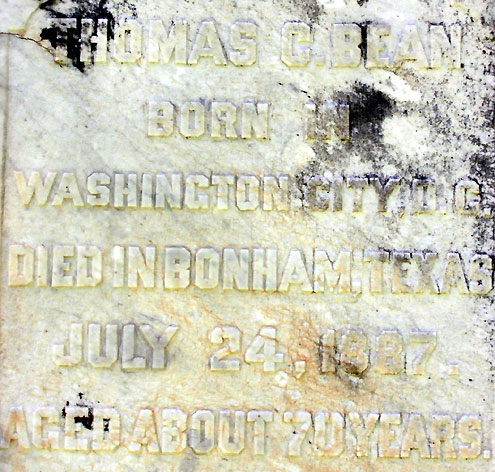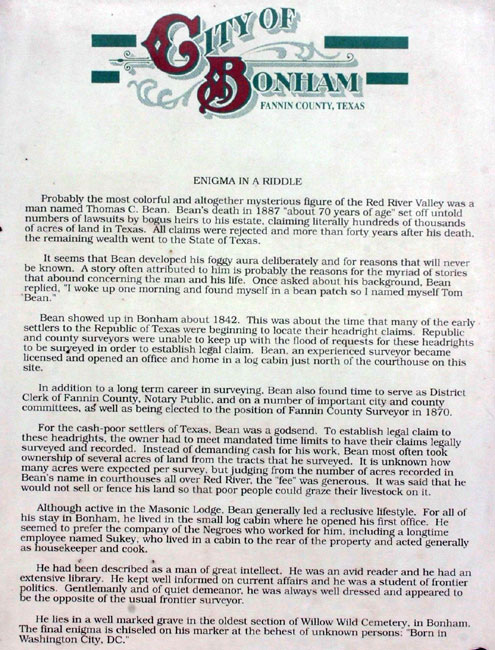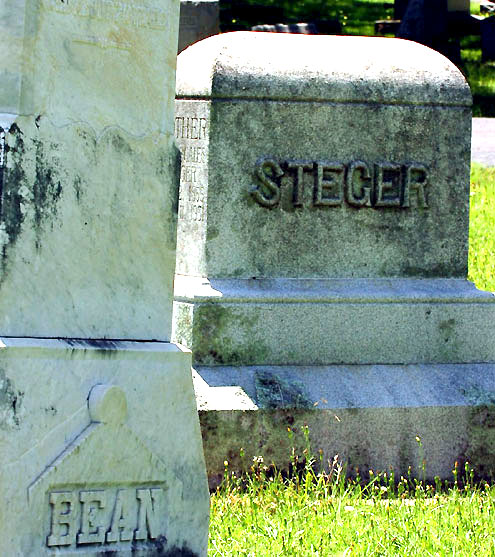At this point, the Steger saga connects with one of the most mysterious and enigmatic characters to ever inhabit Texas as the story takes a detour through Tom Bean. Not Tom Bean proper, but the town's namesake, the one and only Colonel Thomas C. Bean.
Bean first surfaced in this story during a research phase to verify Pulitzer Prize-winning novelist Booth Tarkington had actually written the epitaph on Harry Peyton Steger's gravesite in Willow Wild Cemetery in Bonham. Sure enough, Tarkington's words were there, etched in stone.
But another phrase on a nearby stone also caught my eye that day.
Etched into Tom Bean's headstone were the words, "Born in Washington City, D.C., died in Bonham, Texas on July 24, 1887. Aged about 70 years."

Just so happened that I had my first clue at the riddle of the man we know as Tom Bean.
The story of the accomplishments of the Steger family in North Texas is remarkable in its own right--they owned a grain mill, a lumber yard, and an opera house in Bonham, among other business interests--but maybe the most amazing facet of this story is the outstanding cast of characters that shares the stage with the Stegers and their acquaintances. The Steger family shared history with everyone from Sam Rayburn to a savvy old politician that was an early influence on young Rayburn, Joe Bailey.
Although it has been a little hard to tell at times, this story revolves around the only son of Bonham attorney Thomas P. Steger, a gifted journalist and Rhodes Scholar named Harry Peyton Steger.
Roy Bedichek John Lomax, David Franklin Houston and Booth Tarkington all played prominent roles in Harry Peyton Steger's life. As remarkable as all those men were, Harry will always be best known as the editor who revitalized the career of William Sydney Porter, better known by his nom de plume, O. Henry.
But as fascinating a character as William Sydney Porter turned out to be, he didn't have anything on an enigmatic central figure in a lawsuit that the state turned over to Thomas P. Steger in 1887. Thomas P. Steger was the man appointed to settle the estate of Colonel Thomas C. Bean.

Tom Bean showed up in Bonham about 1842 and over the next four decades he held the record for accumulating the most land and cattle in Fannin County. When Bean died, he also set a record for most kinfolk, although he lived and died a confirmed bachelor.
You see, Bean's estate was estimated to be valued at $300,000 and everybody wanted a piece of the pie, with one claim even coming from as far away as China.
The legal case required a full decade of litigation and caused such a ruckus in Fannin County, it had to be moved over to Grayson County.
But, just who was Tom Bean?
Several authors offer some insight. Much of this information has been gleaned from the writings of a Bonham newspaper columnist, historian and jurist, Judge Will A. Evans.
A History of Fannin County Featuring Pioneer Families by Floy Crandall Hodge was another valuable source, as was A History of Texas and Texans by Frank W. Johnson.
Still, in the end, like any good story, you will have to make up your own mind.
Most accounts have Tom Bean leaving Palmyra, Missouri about 1839, spending time in Fayetteville, Arkansas and then showing in Fannin County around 1842 with Colmore Bean, a man some say was his father while others will only say Colmore Bean claimed to be the father of Tom Bean.
Here is how Frank W. Johnson tells the story of a young surveyor named Tom Bean.
Where the young man was educated is a matter unknown, but he was acquainted with logarithms, latitude and departure, and such other features of higher mathematics as are required to do efficient work in his line. He was a man of mystery from the beginning, but as age crept upon him he grew more reticent about himself and finally reached a point where he resented mildly any attempt of his few friends to gain information about himself or his affairs.
Upon current subject, Col. Bean was sociable and companionable with those who chanced to attract him and seems to have offered no offensive speech except when privacy of his life was threatened with invasion. His services as a surveyor were in demand, and he took land at 25 cents an acre in settlement for his fees for his work. During his life he gathered together many thousands of acres which he refused to put to his own use, to lease or to sell.
When approached by those wishing to lease land from him, Col. Bean generally used his famous expression, "Damn a rat! The poor folks need the pasture."
Bean wished to accumulate nothing but land and was frequently hard pressed for money to pay his taxes and to provide for the few wants of his body. He wore the same plug hat for 25 years, always carried an umbrella, and wore a long, black, sleek coat that served him from the vigor of manhood until his death. He made his home in a cabin about 14-square feet, back of which lived some of his old slaves, and they ministered to him during the lonely hours of his last existence, and when he died, in 1887, the book of his life was closed and sealed and the struggle for his estate began.
Floy Crandall Hodge paints a portrait of Tom Bean as a quiet, reserved gentleman with no close friends, yet he always treated everyone with dignity and respect.
Bean greeted every man he passed with, "How are you today, sir?"
People knew very little about old Tom. They knew him as a lodge master at Constantine Masonic Lodge and also as a possible suitor who never quite materialized for their spinster aunts. He often visited their churches and, although he gave generously, he never joined.
Legend has it that one night in a church service a buxom woman quivered by his side and said, "Oh, Colonel Bean, don't you want to go to heaven?"
The quiet gentleman bowed with his usual courtly grace.
"Well, not tonight, ma'am, not tonight," he said.
Hodge goes on to make a couple of interesting points. First, if people in small towns don't have the whole story, they are more than willing to fill in the blanks. Some local gossipers even claimed Tom Bean's last name was really Sanders, but he had been forced to take an alias after murdering a man. That would certainly fly in the face of all the other accounts of Tom Bean being a peaceful, dignified gentleman.
Hodge volunteered what seems to be the most plausible explanation for Bean's reclusive demeanor and secretive nature. Hodge believes Tom Bean's mother was half-Indian.
That fact alone, given the laws at the time, could have kept the largest land baron in Fannin County from owning land.
Hodge also believed that Bean's real father was a Hessian soldier who fought against the colonies during the American Revolution.
The third author to give us insight into Tom Bean actually knew the man. Will A. Evans graduated from Cumberland Law School in 1859 and moved his wife and two sons to Bonham. Research by local historian Tom Scott tells us that Mr. Evans served several terms as a state representative for Fannin County and then became Fannin County Judge.
In 1883 the Evans family bought The Bonham News and for half a century a member of the Evans family was associated with the paper until it ceased publication in the early 1930s. In 1909, Judge Evans began writing a historical column about the Bonham he had found in 1859. One of Judge Evans' columns centered around an associate, Tom Bean.
Mr. Bean was a licensed lawyer, yet he did not go into courts to practice. He gave legal advice to many friends free of charge, and when suits were absolutely necessary, he most always turned the suits over to this writer, who for several years prior to Colonel Bean's death was his attorney in all business in Fannin County.
Bean did many deeds of charity and gave assistance to many that needed it, but he did not do it for show or ostentation. He did it because he felt like it and wished to do it, but he did not wish to make his deeds of charity public. I have been out with him and traveled some little with him and always found him to be liberal and looking more to the comfort of those with him than he was to his own comfort.
By all accounts, Tom Bean possessed a keen intellect, showed compassion for all of God's creatures and loved good literature, particularly Shakespeare and Dickens. Bean supposedly had an extensive library, which begs the question just how big a library can a man in a 14-square foot cabin own?
According to records of the Constantine Lodge, Tom Bean was the Fannin County Clerk from about 1848 to 1850. Another record shows him as a District Clerk.
In 1861, Tom Bean built his cabin on the lot where 7th and Main Baptist Church is today. While he enjoyed attending balls and parties, most seemed to think Bean was happiest at home surrounded by the people that became his extended family, the African-Americans who worked for him. Sukey, his housekeeper and cook, had a cabin on the same property and was a longtime employee.
Could it have been that Tom Bean understood only too well how the stigma of racism could steal the American dream?
President Abraham Lincoln issued the Emancipation Proclamation on September 22, 1862, although it wasn't until June 19, 1865 that the announcement of the abolition of slavery was proclaimed in Texas.
Twenty-two years later when Tom Bean lay on his deathbed, the people that made his last days bearable were the African-Americans whose company he treasured. I never found where they were part of the deplorable circus of fake relatives that came forward to try and claim the estate.
But I did read that, on the day Tom Bean died, Sukey ran through the streets of Bonham crying.

Previous Steger articles:
http://www.ntxe-news.com/artman/publish/article_110485.shtml
http://www.ntxe-news.com/artman/publish/article_110483.shtml
http://www.ntxe-news.com/artman/publish/article_110478.shtml
http://www.ntxe-news.com/artman/publish/article_110479.shtml
http://www.ntxe-news.com/artman/publish/article_110480.shtml
http://www.ntxe-news.com/artman/publish/article_110481.shtml
http://www.ntxe-news.com/artman/publish/article_110482.shtml
http://www.ntxe-news.com/artman/publish/article_110486.shtml
http://www.ntxe-news.com/artman/publish/article_110487.shtml
http://www.ntxe-news.com/artman/publish/article_110489.shtml
http://www.ntxe-news.com/artman/publish/article_110490.shtml
http://www.ntxe-news.com/artman/publish/article_110491.shtml
http://www.ntxe-news.com/artman/publish/article_110520.shtml
http://www.ntxe-news.com/artman/publish/article_110521.shtml
http://www.ntxe-news.com/artman/publish/article_110522.shtml
http://www.ntxe-news.com/artman/publish/article_110523.shtml
http://www.ntxe-news.com/artman/publish/article_110596.shtml
http://www.ntxe-news.com/artman/publish/article_110597.shtml
http://www.ntxe-news.com/artman/publish/article_110598.shtml
http://www.ntxe-news.com/artman/publish/article_110599.shtml